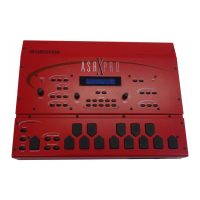Insert Effect Parameters
ENSONIQ ASR-X Pro UserÕs Guide 57
33
33
66
66
GG
GG
uu
uu
ii
ii
tt
tt
aa
aa
rr
rr
AA
AA
mm
mm
pp
pp
This insert effect recreates the warm sound of a tube guitar amplifier. It does this by emulating tube
distortion characteristics.
PP
PP
aa
aa
rr
rr
aa
aa
mm
mm
ee
ee
tt
tt
ee
ee
rr
rr
RR
RR
aa
aa
nn
nn
gg
gg
ee
ee
DD
DD
ee
ee
ss
ss
cc
cc
rr
rr
ii
ii
pp
pp
tt
tt
ii
ii
oo
oo
nn
nn
Pre HP Fc 10Hz to 1.50kHz Filters out the low frequencies before the preamp. The
higher the value, the less low frequencies pass through.
Pre EQ Trim Off, -49.5dB to +24dB Controls the input level to the pre-amp EQ to eliminate
the possibility of clipping boosted signals.
Pre EQ Fc 10Hz to 20.0kHz Determines the center frequency of the parametric filter
before the preamp. Higher values have a brighter sound.
Pre EQ Q 1.0 to 40.0 Determines the width of the resonant peak at the
parametric filter center frequency. While the filter center
parameter determines where (at what frequency) this
peak will occur, the Q setting controls the sharpness of
the peak.
Pre EQ Gain Off, -49.5dB to +24dB Adjusts the amount of boost or cut applied to the
parametric filter in front of the preamp.
Preamp Gain Off, -49.5dB to +24dB Adjusts the amount of boost or cut applied to the
incoming signal. This parameter can be thought of as the
primary distortion stage (clipping). We recommend a
setting of 0 dB, since these emulations were optimized
for distortion there. Lower preamp gains will result in
less distortion, while higher preamp gains will yield
clipping distortion. For low preamp gain, it may be
desirable to use low tube bias values.
Master Level Off, -99dB to 0.0dB This parameter controls the output level of the main
amp.
Tube Bias 0 to 100 For preamp gains approximately 0 dB, this parameter
controls the emphasis of even to odd harmonics which
determines the tone of the amp. Mid values emphasize
even harmonics and offer a warmer Òglowing tubeÓ
sound, while the highest values may sound like tubes
going bad. Tube bias and preamp gain are independent
parameters. For low preamp gain, it may be desirable to
use low tube bias values, because this more closely
imitates the operation of a real amplifier.
Bias Attack 50us to 10.0s Controls the time it takes for the incoming signal to get
to the tube bias. Generally the attack should be short.
Bias Release 50us to 10.0s Sets the amount of time after the incoming signal has
ceased for the amp level to shut down. Generally these
times are longer than the attack times.
Post HP Fc 10Hz to 1.50kHz This parameter filters out the low frequencies of the
main amp prior to the speaker. The higher the value, the
less low frequencies pass through.
Amp BassGain Off, -49.5dB to +24dB Sets the amount of boost or cut applied to the low
shelving filter.
Amp Mid1 Fc 10Hz to 20.0kHz Sets the center of the mid frequency parametric.
Amp Mid1 Q 1.0 to 40.0 This parameter is a bandwidth control that determines
the width of the resonant peak at the center frequency
band. This parameter is equal to the cutoff frequency
divided by the bandwidth. By raising the value, you can
produce a narrower bandwidth.
Amp Mid1Gain Off, -49.5dB to +24dB Sets the amount of boost or cut applied to this mid
frequency parametric.
Amp Mid2 Fc 10Hz to 20.0kHz Identical to the Mid 1 Fc parameter, and is used to
control different bandwidths within the mid range.
Amp Mid2 Q 1.0 to 40.0 Identical to the Mid 1 Q parameter, and is used to
control different bandwidths within the mid range.
Amp Mid2Gain Off, -49.5dB to +24dB Identical to the Mid 1 Gain parameter, and is used to
control different bandwidths within the mid range.
Amp TrebGain Off, -49.5dB to +24dB Sets the amount of boost or cut applied to the high
shelving filter.

